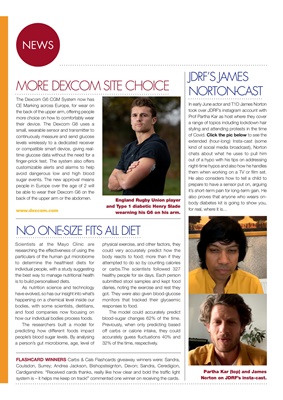
NEWS
MORE DEXCOM SITE CHOICE
The Dexcom G6 CGM System now has
CE Marking across Europe, for wear on
the back of the upper arm, offering people
more choice on how to comfortably wear
their device. The Dexcom G6 uses a
small, wearable sensor and transmitter to
continuously measure and send glucose
levels wirelessly to a dedicated receiver
or compatible smart device, giving realtime glucose data without the need for a
finger-prick test. The system also offers
customizable alerts and alarms to help
avoid dangerous low and high blood
sugar events. The new approval means
people in Europe over the age of 2 will
be able to wear their Dexcom G6 on the
back of the upper arm or the abdomen.
www.dexcom.com
READ MORE ON DEXCOM P.XX
In early June actor and T1D James Norton
took over JDRF's instagram account with
Dr Partha Kar as host where they cover
a range of topics including lockdown hair
styling and attending protests in the time
of Covid. For an extended (hour-long)
Insta-cast (some kind of social media
broadcast), Norton chats about what he
uses to pull him out of a hypo with his tips
on addressing night-time hypos and also
how he handles them when working on a
TV or film set. He also considers how to
tell a child to prepare to have a sensor put
on, arguing it's short-term pain for longterm gain. He also proves
that anyone
who wears on-body diabetes kit is going
to show you, for real, where it is…
JDRF'S JAMES
NORTON-CAST
England Rugby Union player
and Type 1 diabetic Henry Slade
wearning his G6 on his arm.
Scientists at the Mayo Clinic are
researching the effectiveness of using the
particulars of the human gut microbiome
to determine the healthiest diets for
individual people, with a study suggesting
the best way to manage nutritional health
is to build personalised diets.
As nutrition science and technology
have evolved, so has our insight into what's
happening on a chemical level inside our
bodies, with some scientists, dietitians,
and food companies now focusing on
how our individual bodies process foods.
The researchers built a model for
predicting how different foods impact
people's blood sugar levels. By analysing
a person's gut microbiome, age, level of
physical exercise, and other factors, they
could very accurately predict how the
body reacts to food; more than if they
attempted to do so by counting calories
or carbs.The scientists followed 327
healthy people for six days. Each person
submitted stool samples and kept food
diaries, noting the exercise and rest they
got. They were also given blood-glucose
monitors that tracked their glycaemic
responses to food.
The model could accurately predict
blood-sugar changes 62% of the time.
Previously, when only predicting based
off carbs or calorie intake, they could
accurately guess fluctuations 40% and
32% of the time, respectively.
NO ONE-SIZE FITS ALL DIET
FLASHCARD WINNERS Carbs & Cals Flashcards giveaway winners were: Sandra,
Coulsdon, Surrey; Andrea Jackson, Bishopsteignton, Devon; Sandra, Ceredigion,
Cardiganshire. "Received cards thanks, really like how clear and bold the traffic light
system is - it helps me keep on track!" commented one winner on receiving the cards.
Partha Kar (top) and James
Norton on JDRF's insta-cast.